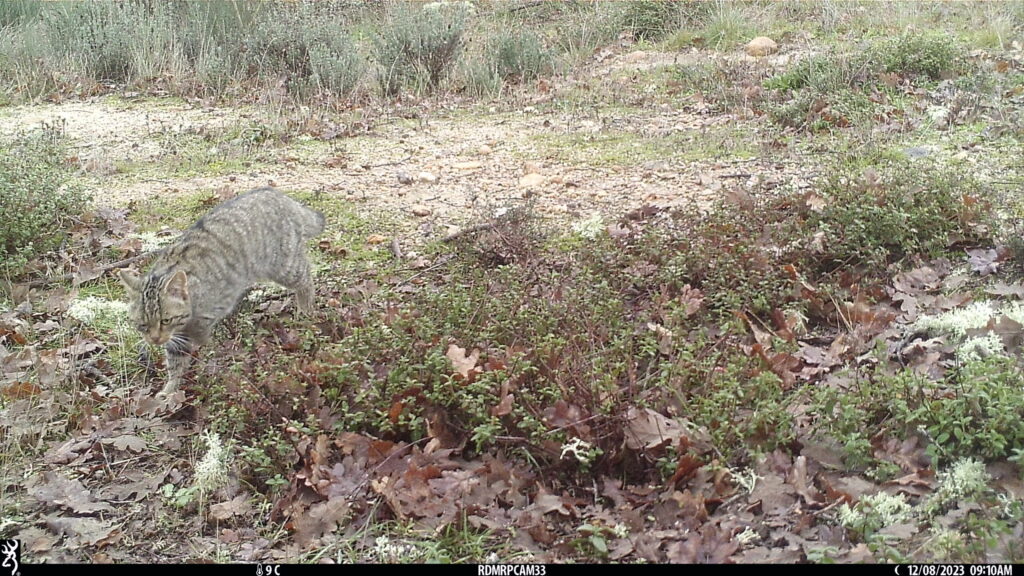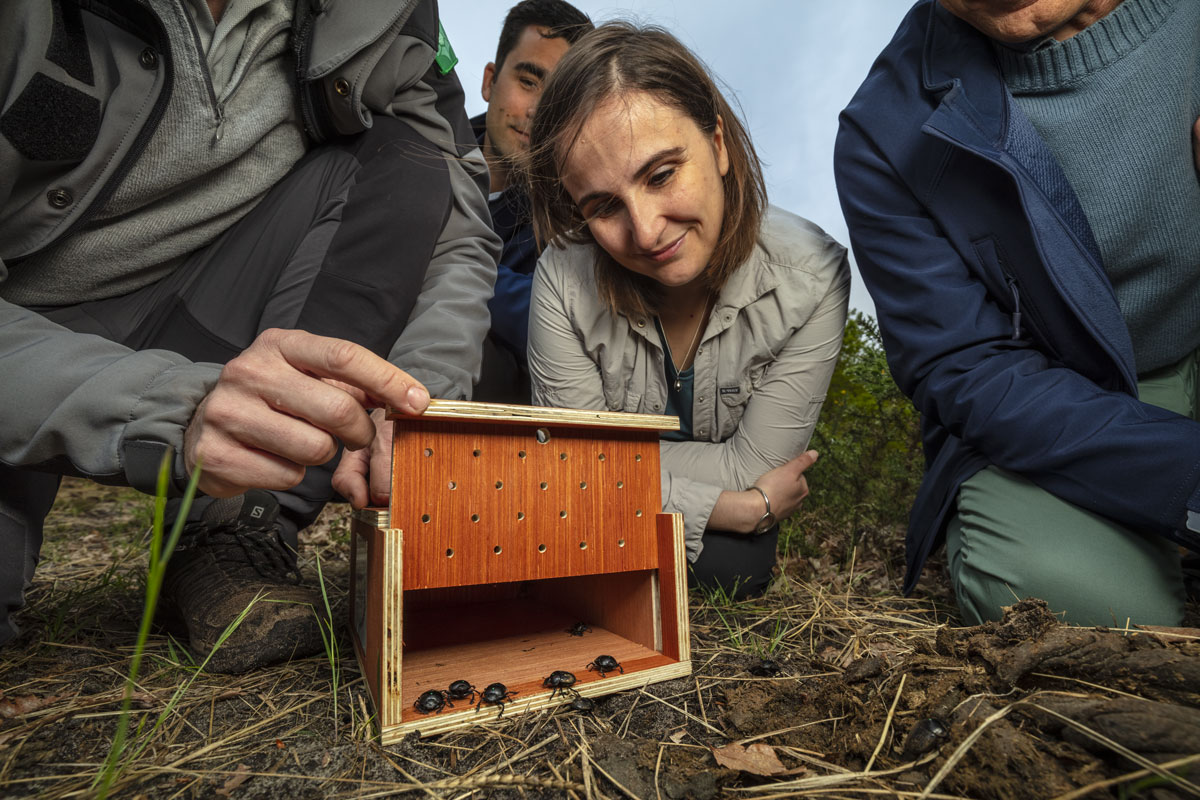The European wildcat is in peril of extinction in Portugal. The primary confirmed sighting of a wildcat inside a Larger Côa Valley rewilding website is due to this fact nice information, highlighting the significance of panorama restoration efforts and focused inhabitants help measures.
Daniel Allen
European wildcats in peril
Right now, giant carnivores resembling wolves and Eurasian lynx are making a comeback throughout many components of Europe. That is nice information – not simply because these are iconic, awe-inspiring animals in their very own proper – but in addition as a result of these keystone apex predators play an vital position sustaining the well being and stability of ecosystems. However there are smaller, much less well-known European carnivores in Europe that additionally play an vital ecological position, and that are equally deserving of our consideration. Certainly one of these is the European wildcat.
A small feline with brown mottled fur and striped markings, the European wildcat is native to continental Europe, Scotland, Turkey, and the Caucasus. Whereas it’s listed as “least concern” by the IUCN, populations have gotten disconnected throughout a lot of its vary on account of important declines, pushed by elements resembling habitat loss and fragmentation, visitors accidents, illness, and hybridisation with home cats. The latter, which may result in the lack of genetic variation or particular variations, means there could also be only a few genetically pure European wildcat populations remaining.
A shock discovery
In Portugal, the European wildcat is near extinction, with lower than 100 grownup cats considered roaming free within the wild. So when one confirmed up lately on a digicam lure, arrange by the Rewilding Portugal workforce on the Paul de Toirões rewilding website throughout the Larger Côa Valley, Rewilding Portugal subject officer Pedro Ribeiro was understandably thrilled and shocked.
“Once I got here throughout the primary picture of the cat I virtually jumped out of my chair,” says the biologist. “It’s extraordinarily uncommon to return throughout wildcats in Portugal – notably within the Côa area. It seemed very very similar to a wildcat within the picture, however as a result of they’re tough to differentiate from home cats, which regularly present up on digicam traps, we wanted to do a bit extra work to make sure.”

Rewilding Portugal
Constructive identification
To substantiate the sighting, Pedro consulted with consultants from Portugal’s Institute for Nature Conservation and Forests (ICNF). A subject survey was subsequently carried out by members of the Rewilding Portugal workforce, which noticed scat collected from the rewilding website. This was despatched to the laboratory of Rewilding Portugal’s strategic associate CIBIO-BIOPOLIS on the College of Porto, the place the CONGEN group, led by Paulo Célio Alves, are growing a genetic and hybridisation research of Iberian wildcats. Members of the group had been in a position to verify, by means of genetic evaluation, that the animal captured on the digicam lure was certainly a wildcat.
“That is the primary time a wildcat has ever been positively recognized in certainly one of our Larger Côa Valley rewilding websites,” says Pedro Ribeiro. “In response to Portugal’s Crimson E book of Mammals, that is the primary confirmed sighting within the Larger Côa Valley, outdoors of the Serra da Malcata, in additional than 30 years. So it’s superb that one has proven up right here.”

Rewilding Portugal
Crucial connectivity
The Rewilding Portugal workforce are establishing a rising variety of rewilding websites throughout the Larger Côa Valley, as they develop a 120,000-hectare wildlife hall to attach the Malcata mountain vary within the south with the bigger Douro Valley within the north. As ecological stepping stones, these websites improve panorama connectivity. In addition they act as refuges the place a various vary of wildlife species can get well and thrive. The confirmed sighting of a wildcat inside certainly one of these websites reveals that the workforce’s ongoing restoration efforts are bearing fruit. Research have proven that panorama connectivity performs a vital position in enabling European wildcats to disperse and enhance genetic variety.

Blue Nomads
Further help measures
Skilful hunters, wildcats assist to maintain native ecosystems in stability by feeding on rabbits and small rodents resembling voles. Along with the varied elements driving wildcat inhabitants decline throughout Europe, the large drop in European rabbit numbers on the Iberian Peninsula over the past century – which has been attributable to the myxomatosis virus, viral haemorrhagic illness, and habitat loss – has additionally had a detrimental influence on native wildcat populations.
The Rewilding Portugal workforce are working to extend the abundance of rabbits within the Larger Côa Valley by means of inhabitants reinforcement, measures to revive habitat, and by working with hunters and personal landowners. This advantages different predators such because the Iberian lynx. They’re additionally planning to help wildcats by supporting the sterilisation of home cats present in shut proximity to rewilding website the place the sighting was confirmed, to decrease the chance of hybridisation.
In 2023, a grant from Rewilding Europe’s European Wildlife Comeback Fund was used to help the discharge of 19 European wildcats in Scotland’s Cairngorms Nationwide Park, with extra releases deliberate this summer season.
Examples of releases supported by the European Wildlife Comeback Fund
Invaluable help
Rewilding Portugal’s efforts within the Larger Côa Valley are supported by the Endangered Landscapes & Seascapes Programme.
Rewilding Europe’s work throughout our rewilding landscapes is supported by a variety of extremely valued companions. We’d notably prefer to acknowledge these offering core funding – notably the Ecological Restoration Fund, the Dutch Postcode Lottery, WWF-Netherlands, and Arcadia. Their longstanding help performs a vital position in enabling us to ship and scale up rewilding influence.


























